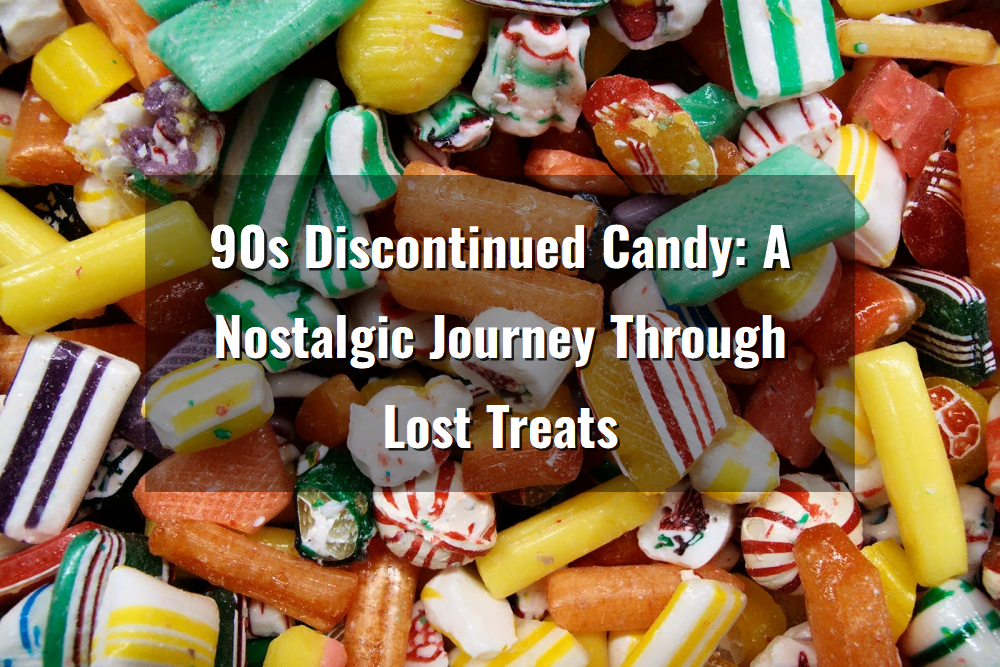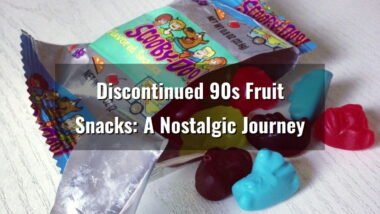Key Takeaways
- Beloved Yet Forgotten: Iconic 90s candies like P.B. Crisp and Hershey’s Bar None were once celebrated for their unique flavors and textures, but have since vanished from US shelves.
- Discontinued for Different Reasons: P.B. Crisp likely disappeared due to low sales, while Hershey’s Bar None, despite its popularity, fell prey to market competition and evolving consumer preferences.
- International Availability: An intriguing twist is that while Hershey’s Bar None no longer graces American candy aisles, it continues to be sold in Mexico, keeping the memory alive for some fans.
- Cultural Impact: These candies, emblematic of 90s innovation in snack foods, have fostered a sense of nostalgia that fuels ongoing online campaigns and petitions for their return.
Referenced Links
- Bring Back PB Crisps! The most delicious snack in the world
- Whatever Happened To Hershey’s Bar None? Have you heard of Hershey’s Bar None?
A Walk Down Memory Lane: The 90s Candy Craze
The 1990s was an era defined by experimentation, bold flavors, and vibrant packaging in the candy world. This period saw an explosion of innovative treats designed to capture the hearts—and taste buds—of kids and adults alike. Among the most memorable were candies that, despite their initial popularity, eventually faded into obscurity. Today, we revisit two such treats: P.B. Crisp and Hershey’s Bar None.
The Rise of 90s Candy
The candy landscape of the 90s was a dynamic mix of creativity and competition. Companies were eager to set themselves apart, offering products that were not only delicious but also a feast for the eyes. Marketing campaigns, unique packaging, and distinctive flavor combinations contributed to a candy revolution that left an indelible mark on pop culture.
In this period of sweet innovation, many candies were introduced with great fanfare. However, as consumer tastes evolved and the market became increasingly competitive, some of these treats failed to sustain their initial momentum. Among them, P.B. Crisp and Hershey’s Bar None stand out as iconic examples of products that, despite a loyal fan base, were eventually discontinued.
P.B. Crisp: The Peanut Butter Delight
Introduced in 1992 by Planters, P.B. Crisp was a peanut butter-filled candy that quickly captured the imagination of candy enthusiasts. The treat boasted a crunchy, cookie-like exterior that set it apart from its contemporaries. Its bright orange and blue packaging, complete with a peanut butter jar logo, made it instantly recognizable on store shelves.
P.B. Crisp was often compared to Reese’s Peanut Butter Cups, though it carved its own niche thanks to its distinct texture—a delicate crunch that contrasted beautifully with the creamy peanut butter inside. Despite this uniqueness, the candy faced challenges in maintaining its market presence. By 1995, the product had been discontinued, with online discussions hinting at low sales as a major factor in its demise. Fans continue to reminisce about the perfect balance of sweet and salty flavors, and campaigns like Bring Back PB Crisps! underscore the lasting appeal of this once-beloved treat.
Hershey’s Bar None: The Chocolate Extravaganza
In contrast, Hershey’s Bar None enjoyed a longer run in the market. Launched in 1986 and making its nationwide debut in 1987 after a successful test in California, this candy quickly established itself as a favorite among chocolate enthusiasts. Initially, the treat featured layers of cocoa wafers, a rich chocolate filling, and crunchy peanuts, all encased in a milk chocolate coating.
In 1992, Hershey’s Bar None underwent a significant reformulation, which saw the introduction of caramel alongside the existing layers of wafers, chocolate, and peanuts. Advertised as “the ultimate chocolate extravaganza,” the candy offered a multi-layered texture that blended sweet, creamy, and crunchy elements into one memorable bite.
Despite its innovative formulation and sustained popularity, Hershey’s Bar None was quietly discontinued in December 1997. Although there has never been an official statement explaining its removal, market competition and shifting consumer preferences are widely believed to have played key roles in its fate. An unexpected twist in the tale of Hershey’s Bar None is that while it vanished from the American market, it continues to be sold in Mexico. This ongoing international availability provides a tantalizing glimpse of hope for nostalgic fans who might seek out the candy through travel or import channels.
Comparing the Two Candy Icons
The story of these two discontinued candies is a fascinating study in how market dynamics and consumer preferences can shape the longevity of a product. Below is a table summarizing the key details and differences between P.B. Crisp and Hershey’s Bar None:
| Candy Name | Release Date | Discontinuation Date | Key Features | Likely Reason for Discontinuation |
|---|---|---|---|---|
| P.B. Crisp | 1992 | 1995 | Peanut butter filling, crunchy cookie shell | Likely low sales, as suggested by fan discussions |
| Hershey’s Bar None | 1986 | 1997 | Cocoa wafers, peanuts, chocolate, caramel (post-1992) | Market competition and evolving consumer preferences |
This side-by-side comparison highlights how even within the same era, different factors such as sales performance, market competition, and product reformulation can influence the lifespan of a candy.
The Broader Impact of 90s Candy Discontinuations
The termination of P.B. Crisp and Hershey’s Bar None reflects candy industry societal shifts as well as commercial considerations. In the 1990s, customers craved more than simply sweets; they wanted experiences, textures, and flavors that fit their changing tastes. Companies tried innovative ingredients and product formats, but not all succeeded.
For many admirers, losing these candies means ending an era. The unique flavors, imaginative packaging, and novelty of these delicacies have endured. Even decades later, eating a P.B. Crisp or admiring Hershey’s Bar None’s layers inspires memories.
Nostalgia and the Revival Movement
In the digital age, nostalgia is stronger than ever. Fans of discontinued candies can share their memories, express their disappointment, and lobby for their return in online communities, forums, and social media.
These grassroots campaigns are about more than restoring a confectionery; they embrace childlike simplicity and delight. The 90s candy aisle was full of surprises and unexpected flavor combinations, and many consider these delights part of their childhood. The ongoing debate and occasional initiatives to bring back these candies show how food can transport us to simpler times and happier times.
The Economic and Marketing Lessons
Economics and marketing lessons can be learned from these candies’ rise and collapse. Understanding consumer behavior is crucial for businesses. P.B. Crisp’s brief existence shows how difficult it is to maintain a product when sales fall short. Despite its popularity, Hershey’s Bar None shows that even popular items can fall victim to tough competition and changing market trends.
Today’s consumers may not appreciate 90s marketing innovations. This shows the need of innovation and flexibility in a fast-changing market. Many firms are using limited edition releases and retro-themed promotions to balance nostalgia with modern expectations.
More Than Just Candy: Cultural Significance
It is important to note that the impact of these discontinued candies extends beyond mere taste. They represent a unique chapter in cultural history—a time when candy companies were unafraid to take risks and experiment with bold new ideas. The disappearance of P.B. Crisp and Hershey’s Bar None marks not only a business decision but also a transformation in the cultural fabric of confectionery.
For many, these candies evoke memories of after-school treats, family gatherings, and the shared excitement of discovering something new and delicious. They serve as a reminder of the joy that comes from trying something innovative and the bittersweet nature of progress, where not every innovation is destined for longevity.
Candy Timeline and Market Dynamics
| Era | Innovation in Candy | Key Examples | Market Outcome |
|---|---|---|---|
| 1980s | Traditional formulations with gradual innovation | Early versions of Hershey’s Bar None | Established candy brands with loyal followings |
| 1990s | Bold flavor combinations, unique textures | P.B. Crisp, Hershey’s Bar None | Mixed success; some discontinued due to low sales or competition |
| 2000s+ | Retro revivals and limited editions | Reintroduced classics like Butterfinger BBs | Leveraging nostalgia for market re-entry |
This table further emphasizes how the candy industry evolved over the decades and how market dynamics can shape the trajectory of even the most innovative products.
A Look Beyond: Other Discontinued 90s Candies
While P.B. Crisp and Hershey’s Bar None remain two of the most talked-about examples, they are part of a broader narrative of discontinued 90s candies. Other treats like Butterfinger BBs and Crispy M&M’s have also experienced changes—whether through reformulations or temporary withdrawals—and their stories contribute to the rich tapestry of candy history. These cases underscore the challenges faced by manufacturers in striking the right balance between innovation, consumer preference, and market viability.
The Future of Nostalgic Candies
Today, the revival of nostalgic candies is not just a sentimental journey but also a strategic move by some companies to tap into the powerful emotions associated with food memories. Limited edition re-releases, retro packaging, and even social media teasers are all part of the modern marketing toolkit aimed at rekindling the magic of these lost treats. The continued interest in products like Hershey’s Bar None, available in select international markets, suggests that there remains a substantial market for nostalgic candy experiences.
FAQ
What made 90s candies like P.B. Crisp and Hershey’s Bar None so popular?
The 90s were a time of experimentation in the candy industry. Companies introduced innovative flavors and textures that captured the imagination of consumers. P.B. Crisp stood out with its unique crunchy, peanut butter-filled exterior, while Hershey’s Bar None offered a layered experience with cocoa wafers, peanuts, and later, caramel. Their eye-catching packaging and novel taste combinations made them instant favorites among kids and adults alike.
Why were these candies discontinued?
While there is no single explanation for the discontinuation of these candies, several factors likely contributed. P.B. Crisp appears to have been discontinued around 1995 due to low sales and a limited market appeal compared to competing products. On the other hand, Hershey’s Bar None, despite its popularity, was likely affected by intense market competition and changing consumer preferences, leading to its eventual removal from US shelves in 1997.
Are there any efforts to bring these candies back?
Yes, nostalgia has spurred several fan-led campaigns and online petitions. While these campaigns have garnered support from dedicated fans, there have been no official announcements from the companies regarding a full-scale revival of these products. However, the continued availability of Hershey’s Bar None in markets like Mexico keeps the hope alive for a potential comeback in the future.
What other 90s candies have faced a similar fate?
Besides P.B. Crisp and Hershey’s Bar None, several other 90s candies have experienced discontinuations or reformulations. Treats like Butterfinger BBs and Crispy M&M’s have undergone changes over the years, with some making brief returns in limited editions. These examples highlight the broader trend of the candy industry continually evolving to match consumer tastes and market conditions.
How has the discontinuation of these candies affected pop culture?
The disappearance of these iconic candies has left a lasting mark on pop culture. For many, these treats are not just snacks but cherished memories of childhood. Online discussions, social media posts, and nostalgia-driven articles attest to the enduring emotional connection that fans have with these products. The desire to relive those moments continues to inspire petitions and retro-themed marketing campaigns, making these candies cultural icons in their own right.




